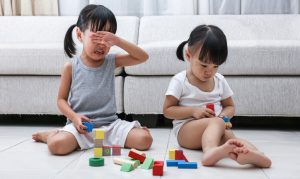
Toddlers have a different way of regulating emotions than adults do because they are still learning about their feelings and how to cope with them. A recent study contains helpful insight into how young children begin to manage those intense feelings and how their strategies shift as they grow.
Researchers followed a group of toddlers at 24 months and again at 30 months, observing how they reacted during two challenging situations: one designed to spark fear and another meant to create frustration and anger. What the researchers found is that toddlers don’t regulate all emotions the same way. In fact, they use very different tools depending on whether they’re scared or upset.
When toddlers felt afraid, they relied mainly on themselves. They pulled away from the scary object, avoided it, or used small soothing behaviors to calm down. Fear naturally pushes children to protect themselves, so these self-driven responses make sense. Toddlers seemed to understand, even at such a young age, that fear is about staying safe.
When they measured anger in toddlers, it looked very different. When something blocked their goal, like a toy being taken away, toddlers turned toward their caregivers. They sought attention, tried to get help, or looked to their parent for comfort or support. Anger’s purpose is to overcome obstacles, and young children often realize that turning to a trusted adult is the quickest route to getting things back on track.
From this study, they found that emotional development in toddlerhood isn’t a simple march from “immature” to “mature” behaviors. Instead, toddlers are learning which strategies work best in different situations. The ability to choose the right response for the moment is a key sign of healthy emotional growth.
Each moment of fear or frustration gives toddlers a chance to test out new ways of coping, whether that means calming themselves or seeking your help. And as they grow, they become increasingly skilled at picking the strategy that helps them feel balanced again. Understanding this can make it a little easier to support your toddler through those ups and downs.
If you want to read more, click here!
Angelina Stofka
UConn KIDS, Research Assistant